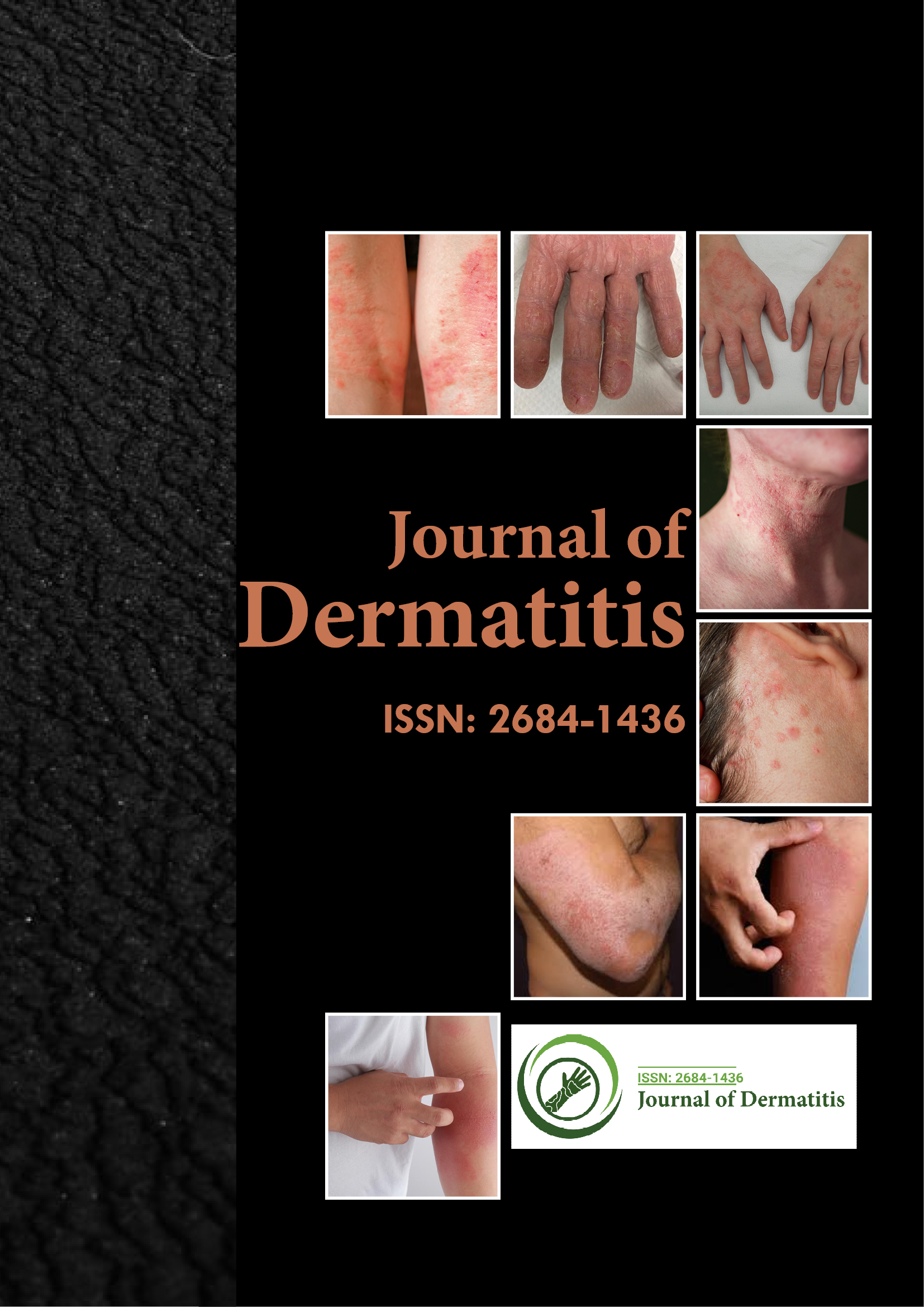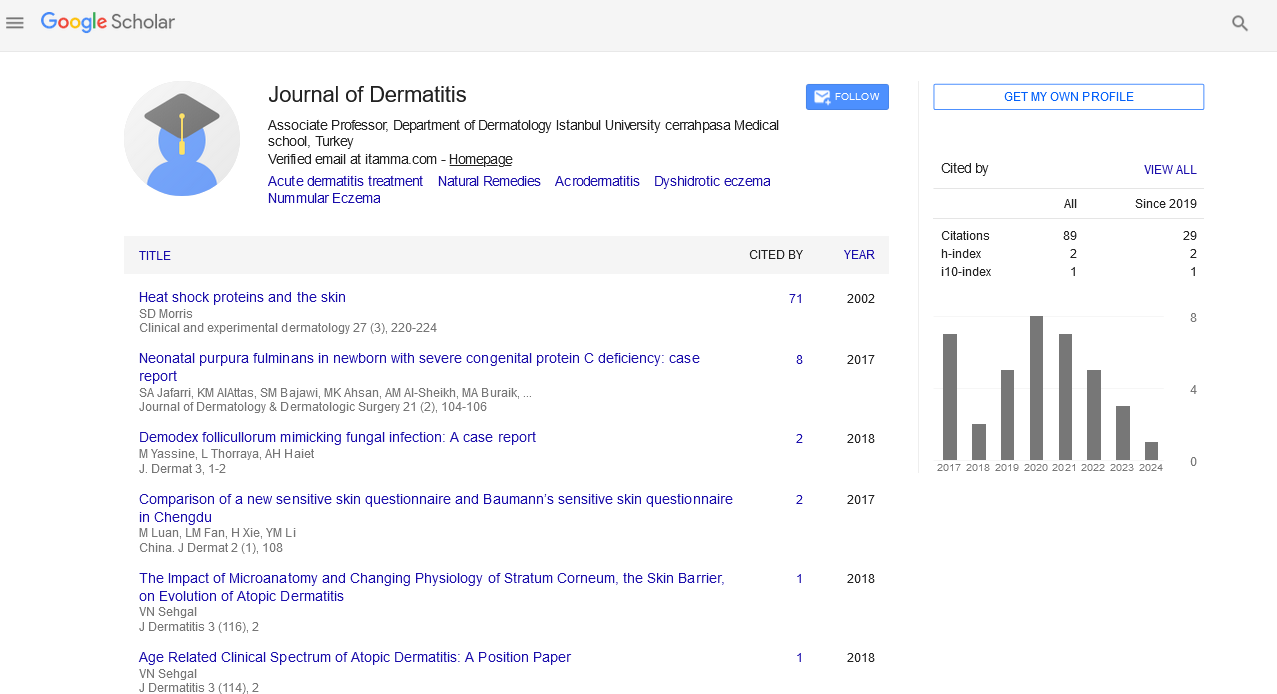Indexed In
- RefSeek
- Hamdard University
- EBSCO A-Z
- Euro Pub
- Google Scholar
Useful Links
Share This Page
Journal Flyer

Open Access Journals
- Agri and Aquaculture
- Biochemistry
- Bioinformatics & Systems Biology
- Business & Management
- Chemistry
- Clinical Sciences
- Engineering
- Food & Nutrition
- General Science
- Genetics & Molecular Biology
- Immunology & Microbiology
- Medical Sciences
- Neuroscience & Psychology
- Nursing & Health Care
- Pharmaceutical Sciences
Perspective - (2023) Volume 8, Issue 6
Neurodermatitis and its Manifestations, Aetiology, and Possible Therapies
Shi Zhang*Received: 17-Aug-2023, Manuscript No. JOD-23-23561; Editor assigned: 21-Aug-2023, Pre QC No. JOD-23-23561 (PQ); Reviewed: 04-Sep-2023, QC No. JOD-23-23561; Revised: 11-Sep-2023, Manuscript No. JOD-23-23561 (R); Published: 19-Sep-2023, DOI: 10.35248/2684-1436.23.8.221
Description
Neurodermatitis, also known as lichen simplex chronicus, is a skin condition characterized by chronic itching and the development of thick, scaly patches on the skin. This dermatological disorder can have a significant impact on a quality of life, as the incessant itching can be both physically and emotionally distressing. It describes the manifestations, aetiology, and possible therapies for neurodermatitis.
Manifestations
The manifestation of neurodermatitis is intense itching, which is often triggered or exacerbated by stress or emotional factors. As individuals scratch the affected area, the skin becomes increasingly irritated, leading to the development of thick, leathery, and scaly patches. These patches are typically found on the neck, wrist, forearm, thigh, ankle, and the genital region.
The incessant scratching and rubbing can cause the affected skin to become discolored, which can lead to further distress for the individual. In severe cases, the constant scratching may cause open sores, increasing the risk of infection.
Aetiology
The exact cause of neurodermatitis is not fully understood, but it is believed to be multifactorial. This condition may occur as a result of various factors, including:
Genetics: Some individuals may have a genetic predisposition to develop neurodermatitis, as it can run in families.
Skin barrier dysfunction: People with impaired skin barrier function are more susceptible to neurodermatitis. This barrier dysfunction allows allergens and irritants to penetrate the skin more easily.
Stress and emotional factors: Stress, anxiety, and other emotional factors can exacerbate itching and contribute to the development of neurodermatitis. Stress can trigger a vicious cycle of itching and scratching, worsening the condition.
Skin irritants: Exposure to irritants, such as harsh soaps, chemicals, or allergens, can lead to skin irritation and trigger the development of neurodermatitis.
Possible therapies
Management and treatment of neurodermatitis focus on relieving itching, preventing skin damage, and addressing underlying causes. Therapies for neurodermatitis may include:
Topical corticosteroids: These medications can help reduce inflammation and itching. They are typically prescribed for short periods to avoid side effects like skin thinning.
Topical calcineurin inhibitors: These non-steroidal medications can be used to reduce inflammation and itching and are particularly useful for sensitive areas like the face and genitals.
Moisturizers: Regular use of moisturizers can help maintain skin hydration and reduce the severity of neurodermatitis. Thick, emollient creams are often recommended.
Antihistamines: Over-the-counter or prescription antihistamines can help relieve itching, especially when taken at bedtime to improve sleep quality.
Psychological support: Because stress and emotional factors play a significant role in neurodermatitis, therapy and stress management techniques may be beneficial in managing the condition.
Avoiding triggers: Identifying and avoiding triggers like harsh soaps, allergens, and irritants can help prevent flare-ups.
Phototherapy: In some cases, exposure to controlled amounts of ultraviolet (UV) light may be recommended. UVB phototherapy can help alleviate symptoms.
Oral medications: In severe cases, oral corticosteroids or other immunosuppressive medications may be prescribed, but their use is typically limited to short periods due to potential side effects.
It is essential for individuals with neurodermatitis to work closely with a dermatologist to develop a personalized treatment plan to their specific needs and to monitor the condition's progress. Long-term management and lifestyle modifications are often necessary to prevent recurrences.
In conclusion, neurodermatitis is a chronic skin condition characterized by persistent itching and the development of thick, scaly patches. While the exact cause remains unclear, acombination of genetic, environmental, and emotional factors likely contributes to its development. Therapies for neurodermatitis focus on reducing itching, preventing skin damage, and addressing underlying causes, with a combination of topical treatments, psychological support, and lifestyle modifications often being the most effective approach to managing this challenging condition.
Citation: Zhang S (2023) Neurodermatitis and its Manifestations, Aetiology, and Possible Therapies. J Dermatitis. 8:221.
Copyright: © 2023 Zhang S. This is an open-access article distributed under the terms of the Creative Commons Attribution License, which permits unrestricted use, distribution, and reproduction in any medium, provided the original author and source are credited.

